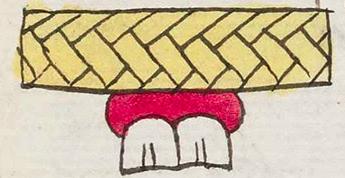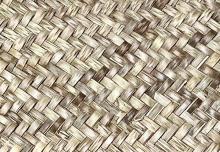Petlatlan (Mdz38r)
This compound glyph represents the place name Petlatlan. At the top is the element of the woven mat (petlatl), and below that the teeth (tlantli) that provide the phonetic value of the locative suffix, -tlan. The horizontal petlatl is a standard yellow color, and the classic weaving pattern is like a herringbone. The teeth are the very typical two front teeth, white, with red gums above them.
Stephanie Wood
It is important to remember that the teeth have no meaning in the place name; rather, they provide the phonetic element for the locative suffix. And, it is clear from the gloss that the suffix is -tlan (near) and not -tla or tlah (place of abundance of).
Stephanie Wood
petlatlan / puo
Petlatlan, pueblo
Stephanie Wood
c. 1541, or by 1553 at the latest
Stephanie Wood
mats, petates, teeth, dientes, nombres de lugares
This detail of a petlatl (petate, or woven mat) was part of an exhibit, “Tlatelolco <> Kreuzberg,” in the former Colegio de Santa Cruz Tlatelolco, in the building of Relaciones Exteriores, CDMX. Curator, Emil Becerril. Photo by S. Wood, 2 May 2025.

petla(tl)<, woven mat, https://nahuatl.wired-humanities.org/content/petlatl
-tlan (locative suffix), https://nahuatl.wired-humanities.org/content/tlan
"Reed Mat Place" [Frances Karttunen, unpublished manuscript, used here with her permission.]
"Where There are Many Mats" (Berdan and Anawalt, 1992, vol. 1, 199)
"El Lugar de Petates"
Stephanie Wood
Codex Mendoza, folio 38 recto, https://digital.bodleian.ox.ac.uk/objects/2fea788e-2aa2-4f08-b6d9-648c00..., image 86 of 188.
The Bodleian Libraries, University of Oxford, hold the original manuscript, the MS. Arch. Selden. A. 1. This image is published here under the UK Creative Commons, “Attribution-NonCommercial-ShareAlike 3.0 License” (CC-BY-NC-SA 3.0).



